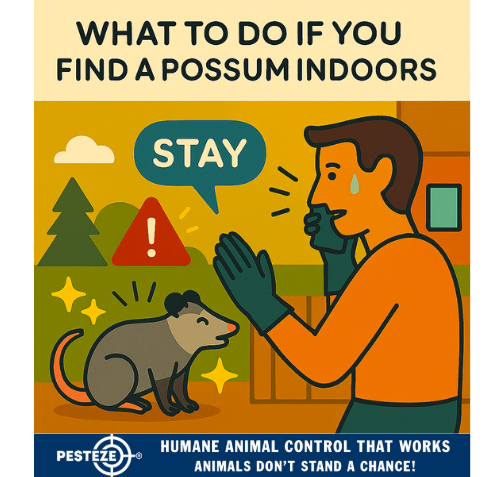WHAT TO DO IF YOU FIND A POSSUM INDOORS

WHAT TO DO IF YOU FIND A POSSUM INDOORS
SUMMARY
Finding a possum inside your home can be startling, but it’s important to stay calm and act wisely. Possums are generally non-aggressive and more scared of you than you are of them. This guide outlines safe, humane, and effective steps to remove a possum from your indoor space, prevent future entries, and stay compliant with local wildlife laws. With the right approach, you can protect your home and help the animal return to its natural habitat.
FEATURES
-
Stay Calm and Avoid Confrontation: Do not corner or attempt to touch the possum—it may feel threatened.
-
Close Off Access Points: Seal off rooms and exits to contain the possum in one area.
-
Create a Clear Exit Path: Open doors or windows to allow the possum to leave on its own.
-
Use Gentle Guidance Tools: Brooms or boards can help direct the possum without physical contact.
-
Call Wildlife Professionals if Needed: Contact local animal control or wildlife rehabilitators for safe removal.
-
Inspect and Seal Entry Points: Check for gaps, vents, or broken screens to prevent future intrusions.
GUIDE DESCRIPTION
Possums are nocturnal, solitary animals that occasionally wander into homes in search of food or shelter. If you find one indoors, your goal should be to remove it safely and prevent future visits—without causing harm to the animal or yourself.
Start by staying calm. Possums are not typically aggressive and will often freeze or play dead when frightened. Avoid loud noises, sudden movements, or attempts to grab the animal. Instead, observe from a distance and keep pets and children away.
Contain the possum by closing doors to other rooms and blocking off escape routes. This helps prevent it from hiding in hard-to-reach areas like attics, basements, or behind furniture.
Next, create a clear exit path. Open a nearby door or window that leads outside. Turn off indoor lights and leave the exit area well-lit to encourage the possum to move toward it. You can gently guide the animal using a broom or board, but never poke or prod.
If the possum refuses to leave or appears injured, contact local wildlife control or a licensed rehabilitator. They have the tools and expertise to remove the animal safely and legally.
Once the possum is gone, inspect your home for entry points. Common access areas include pet doors, broken screens, open vents, and gaps in roofing or siding. Seal these areas with durable materials to prevent future intrusions.
By responding calmly and responsibly, you’ll protect your home and help the possum return to its natural environment without harm.
- Amy Chang


Comments 0